4 posts tagged with "AWS IoT Core"
AWS IoT Core
View All TagsAWS IoT Core – Iron Man – Part 1
Bought the Iron Man Mark 3 3D Printing model designs from https://www.wf3d.shop/products/ironman-mark-3-suit-3d-printable-model by Walsh3D
Printed these so far:
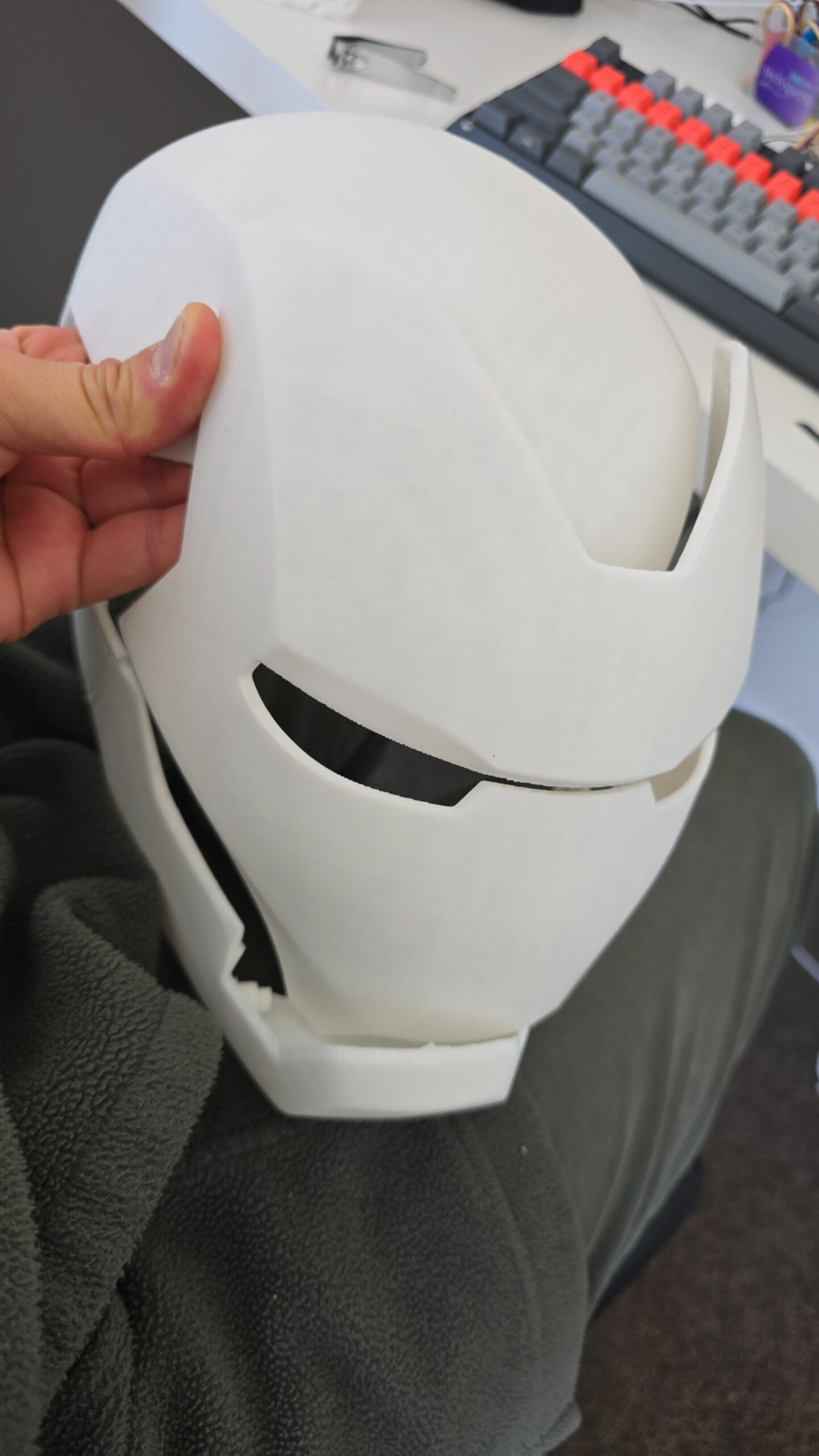
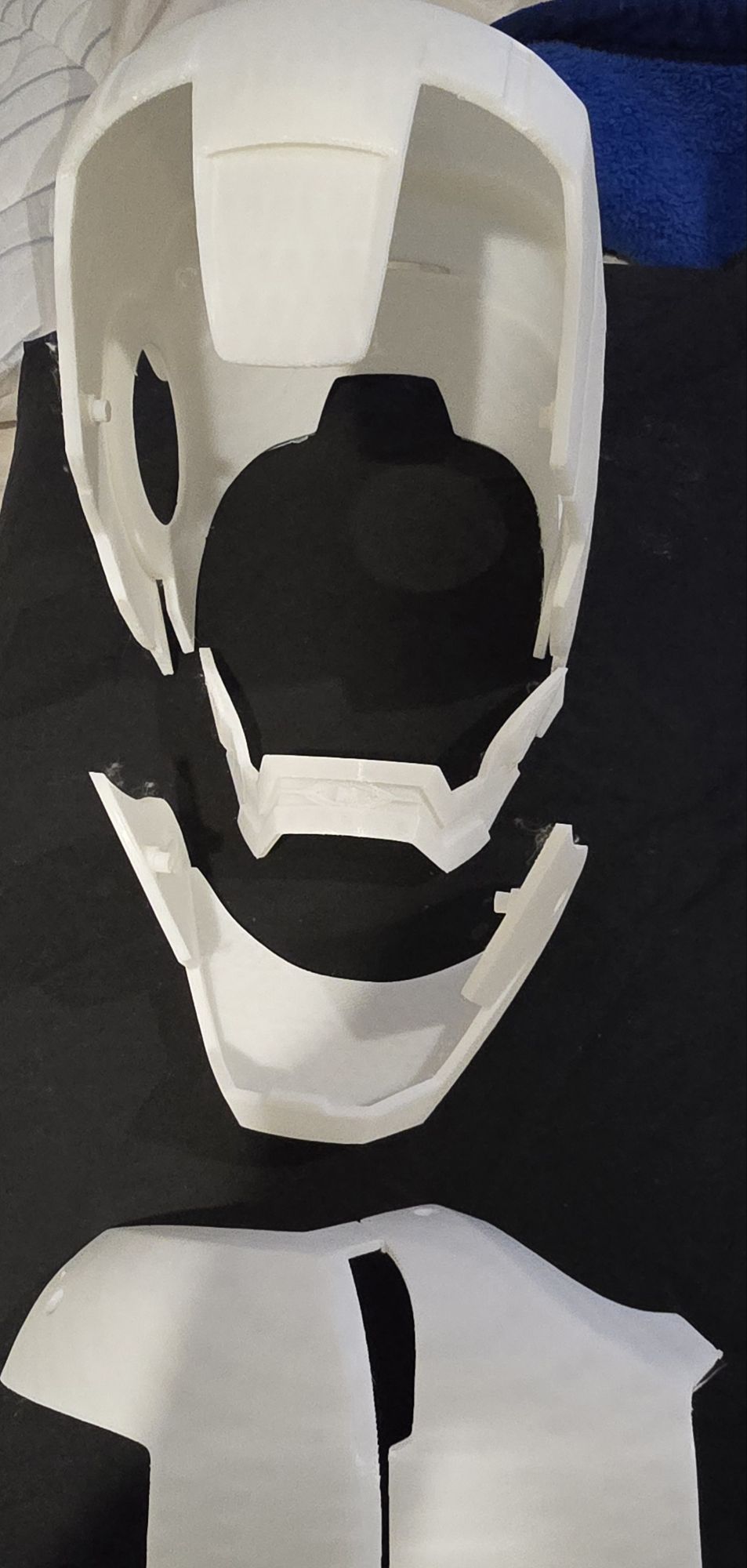
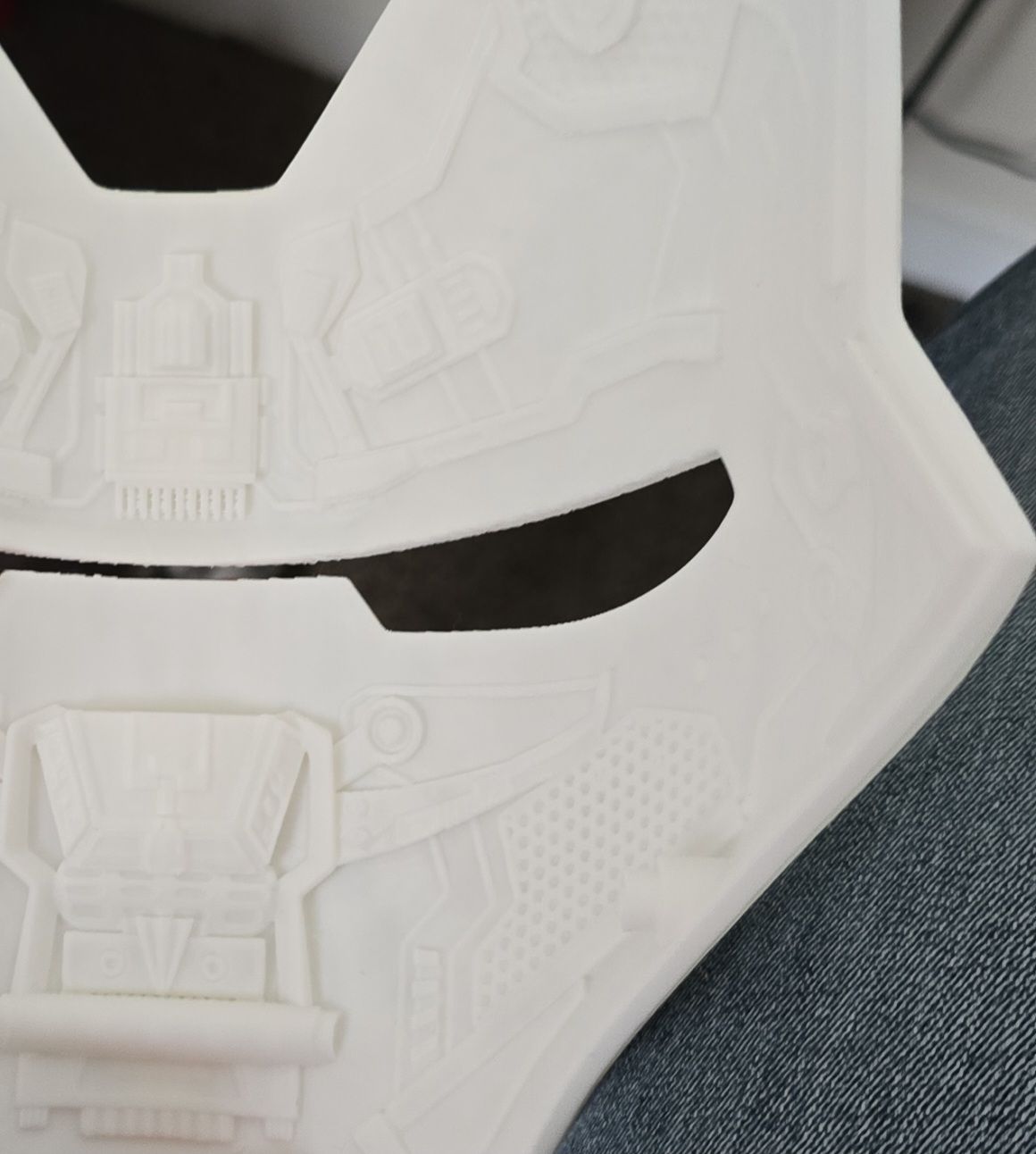
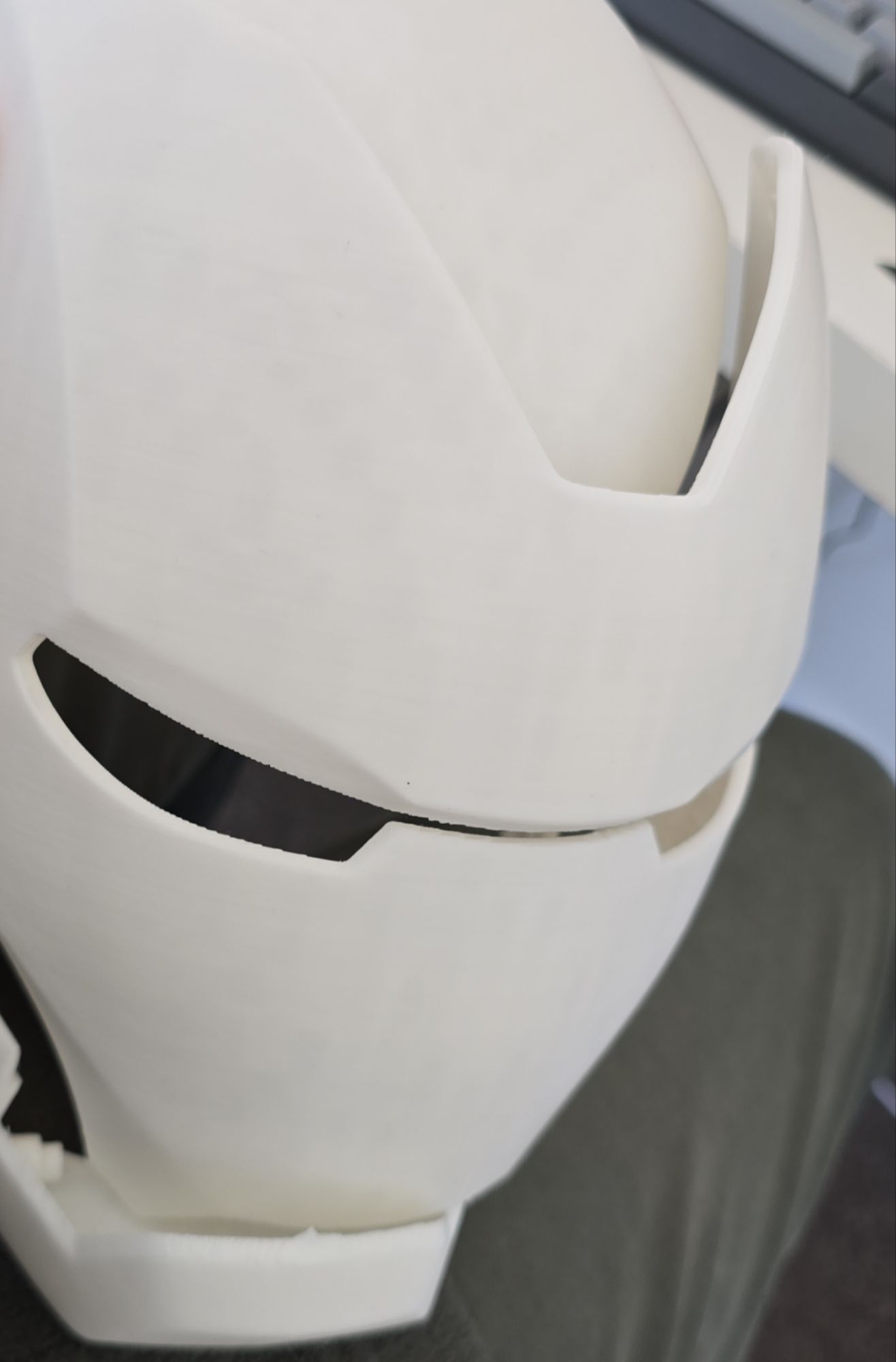
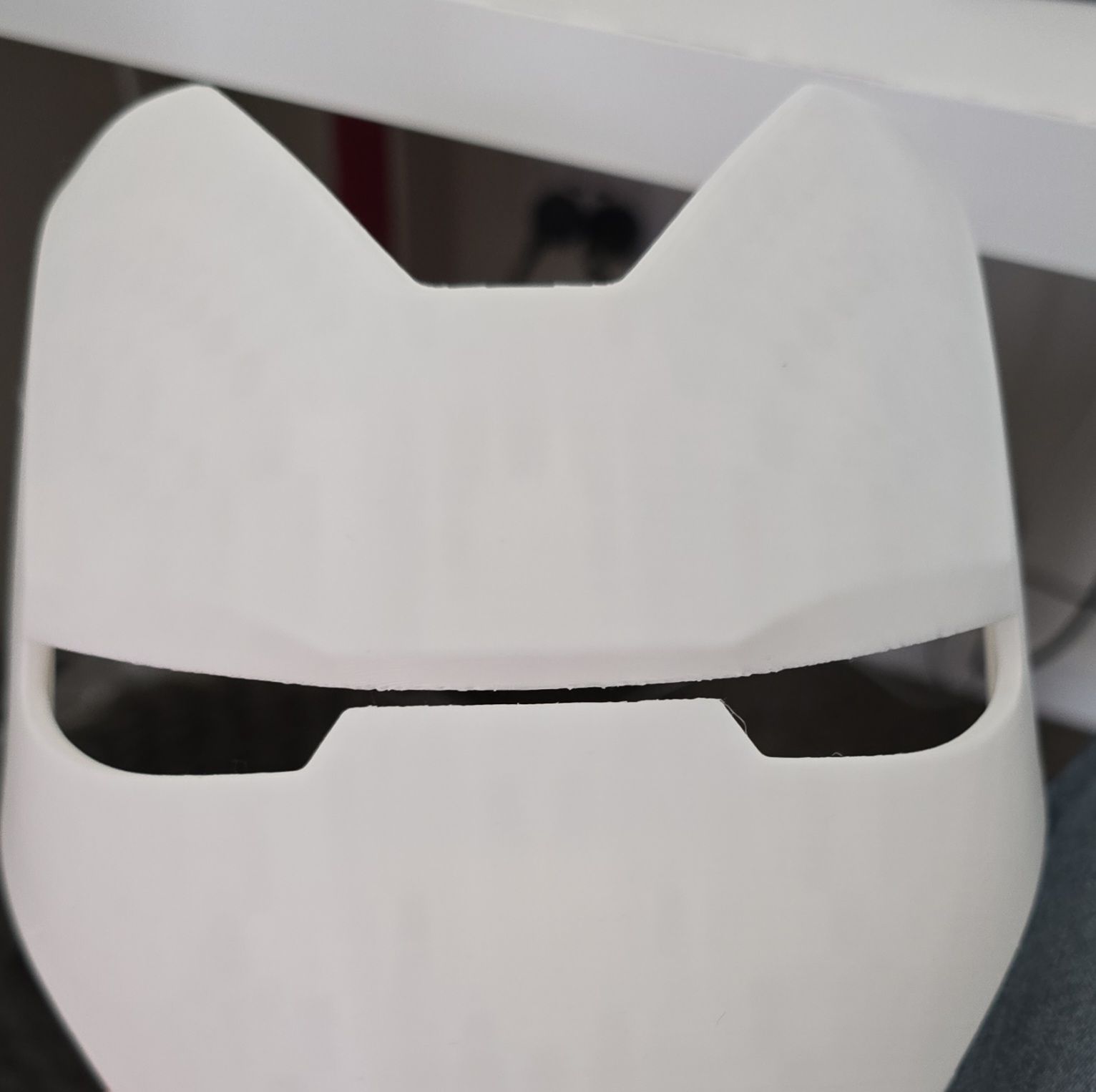

FeedMyFurBabies – Send and Receive MQTT messages between AWS IoT Core and your micro-controller – I am switching from Arduino CPP to MicroPython
Recently I switched my Cat Feeder project's IaC to AWS CDK in favour of increasing my focus and productivity on building and iterating, rather than constantly mucking around with infrastructure everytime I resume my project after a break; which is rare and far between these days.
Just as with coding IoT microcontrollers such as the ESP32s, I want to get straight back into building every opportunity I get; so I am also switching away from Arduino based microcontroller development written in C++ - I don't have a background in C++ and to be honest this is the aspect I struggled with the most because I tend to forget things after not touching it for 6 months or so.
So I am switching to MicroPython to develop the logic for all my IoT devices going forward, this means I get to use Python - a programming lanaguge I work with frequently so there is less chance of me being forgetful when I use it at least once a month. MicroPython is a lean and efficient implementation of the Python 3 programming language that includes a subset of the Python standard library and is optimized to run on microcontrollers and in constrained environments - a good fit for IoT devices such as the ESP32!
What about all the Arduino hardware and components I already invested in?
Good news is MircoPython is supported on all ESP32 devices - based on the ones I myself have purchased; all I need to do to each ESP32 device is to flash it with a firmware - if you are impatient, you can scroll down and skip to below to the flashing the firmware section. When I first started Arduino, MicroPython was available to use, but that was 2 years ago and there were not as many good blog and tutorial content out there as there is today; I couldn't at the time work out how to control components such as sensors, servos and motors as well as I could with C++ based coding using Arduino; nowdays there are way more content to learn off and I've learnt (by PoCing individual components) enough to switch to MicroPython. As far as I understand it, any components you have for Arduino can be used in MicroPython, provided that there is a library out there that supports it, if there isn't then you can always write your own!
What's covered in this blog?
By the end of this blog, you will be able to send and receive MQTT messages from AWS IoT core using MicroPython, I will also cover the steps involved in flashing a MicroPython firmware image onto an ESP32C3. Although this blog has a focus and example on using an ESP32, this example can be applied to any micro-controllers of any brand or flavours, provided the micro-controller you are using supports MicroPython.
Flashing the MicroPython firmware onto a Seeed Studio XIAO ESP32C3
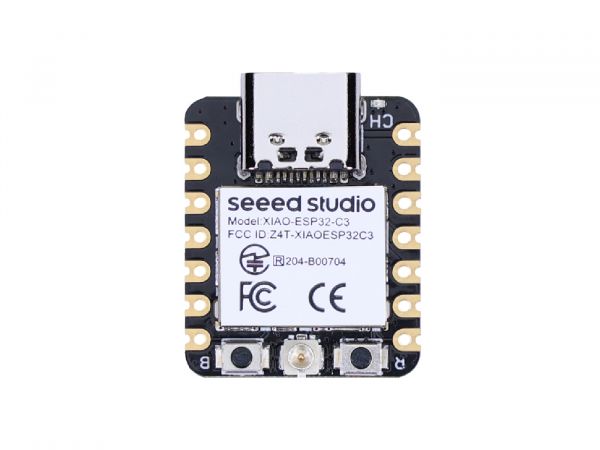
The following instructions works for any generic ESP32C3 devices!
Download the latest firmware from micropython.org
https://micropython.org/download/ESP32_GENERIC_C3/
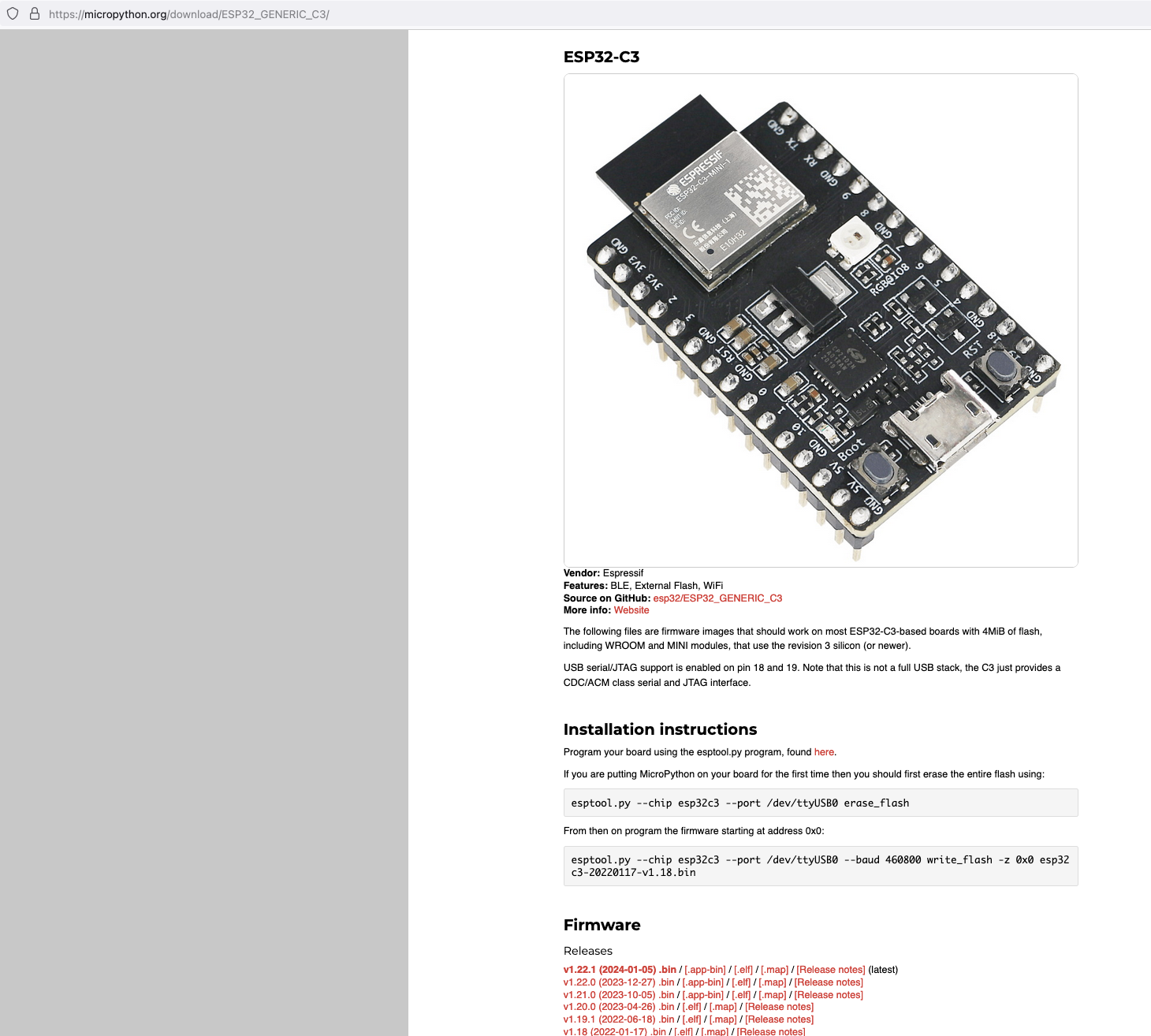
Next, I connected my ESP32C3 to my Mac and ran the following command to find the name of the device port
/dev/ttyUSB0
![]()
My ESP32C3 is named "/dev/tty.usbmodem142401", the name for your ESP32C3 may be different.
Next, install esptool onto your computer, then run the following commands to flash the MicroPython firmware onto the ESP32C3 using the bin file you've just downloaded.
esptool.py --chip esp32c3 --port /dev/tty.usbmodem142401 erase_flash
esptool.py --chip esp32c3 --port /dev/tty.usbmodem142401 --baud 460800 write_flash -z 0x0 ESP32_GENERIC_C3-20240105-v1.22.1.bin
It should look something like this when you run the commands.
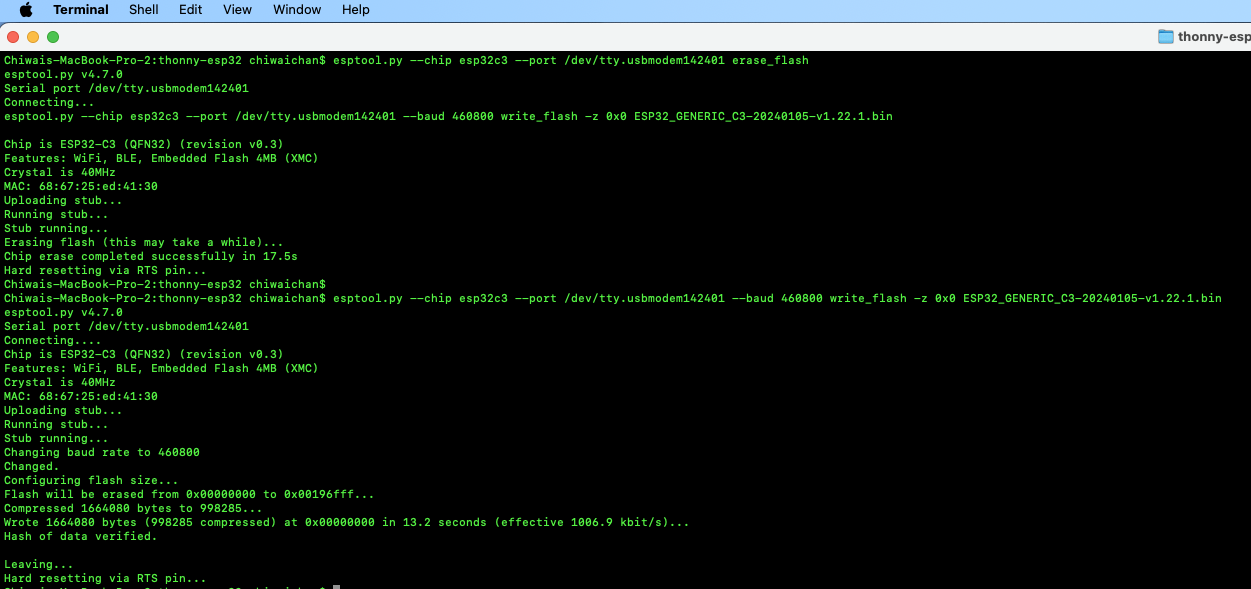
Install Thonny and run it. Then go to Tools -> Options, to configure the ESP32C3 device in Thonny to match the settings shown in the screenshot below.
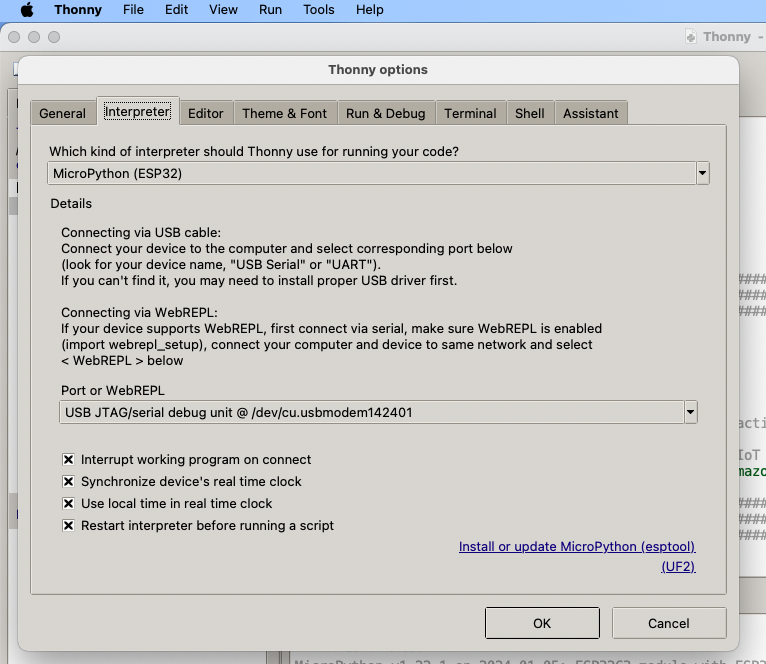
If everything went well, you should see these 2 sections in Thonny: "MicroPython Device" and "Shell", if not then try clicking on the Stop button in the top menu.
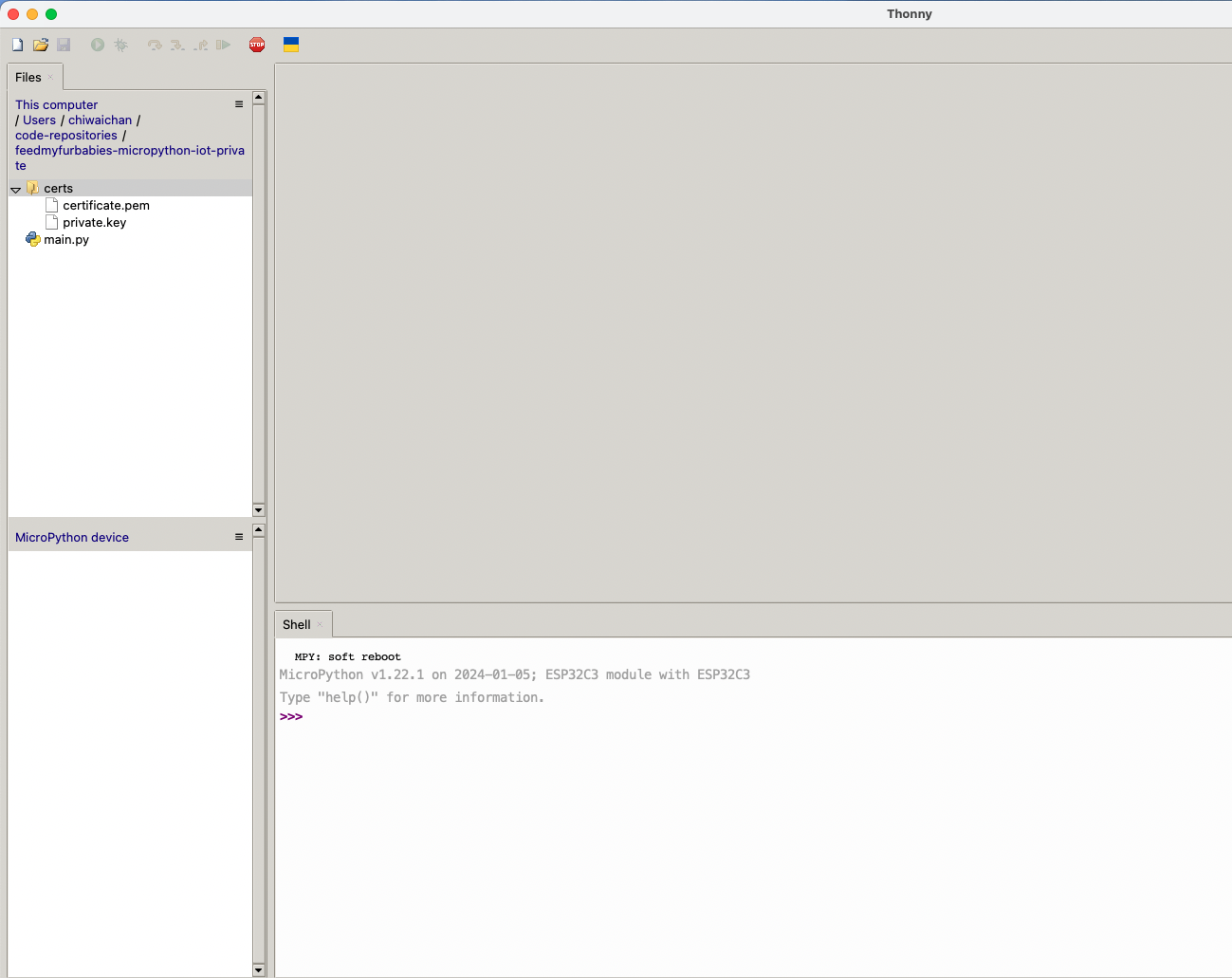
AWS IoT Core Certificates and Keys
In order to send MQTT messages to an AWS IoT Core Topic, or to receive a message from a Topic in reverse, you will need a set of Certificate and Key\s for your micro-controller; as well as the AWS IoT Endpoint specific to your AWS Account and Region.
It's great if you have those with you so you can skip to the next section, if not, do not worry I've got you covered. In a past blog I have a reference architecture accompanied by a GitHub repository on how to deploy resources for an AWS IoT Core solution using AWS CDK, follow that blog to the end and you will have a set of Certificate and Key to use for this MicroPython example; the CDK Stack will deploy all the neccessary resources and policies in AWS IoT Core to enable you to both send and receive MQTT messages to two separate IoT Topics.
Reference AWS IoT Core Architecture: https://chiwaichan.co.nz/blog/2024/02/02/feedmyfurbabies-i-am-switching-to-aws-cdk/
Upload the MicroPython Code to your device
Now lets upload the MicroPython code to your micro-controller and prepare the IoT Certificate and Key so we can use it to authenticate the micro-controller to enable it to send and receive MQTT messages between your micro-controller and IoT Core.
Clone my GitHub repository that contains the MicroPython example code to publish and receive MQTT message with AWS IoT Core: https://github.com/chiwaichan/feedmyfurbabies-micropython-iot
It should look something like this.
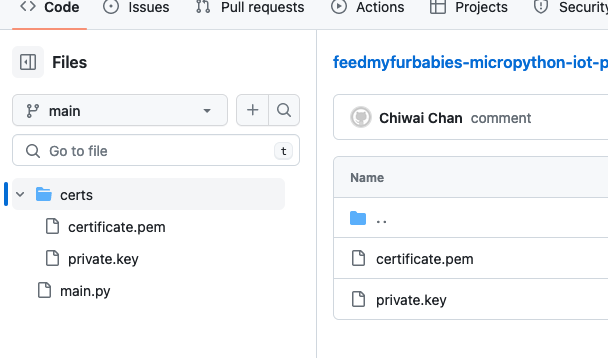
Copy your Certificate and Key into the respective files shown in the above screenshot; otherwise, if you are using the Certificate and Key from my reference architecture, then you should use the 2 Systems Manager Parameter Store values create by the CDK Stack.

Next we convert the Certificate and Key to DER format - converting the files to DER format turns it into a binary format and makes the files more compact, especially neccessary when we run use it on small devices like the ESP32s.
In a terminal go to the certs directory and run the following commands to convert the certificate.pem and private.key files into DER format.
openssl rsa -in private.key -out key.der -outform DER
openssl x509 -in certificate.pem -out cert.der -outform DER
You should see two new files with the DER extension appear in the directory if all goes well; if not, you probably need to install openssl.
In Thonny, in the Files explorer, navigate to the GitHub repository's Root directory and open the main.py file. Fill in the values for the variables shown in the screenshot below to match your environment, if you are using my AWS CDK IoT referenece architecture then you are only required to fill in the WIFI details and the AWS IoT Endpoint specific to your AWS Account and Region.
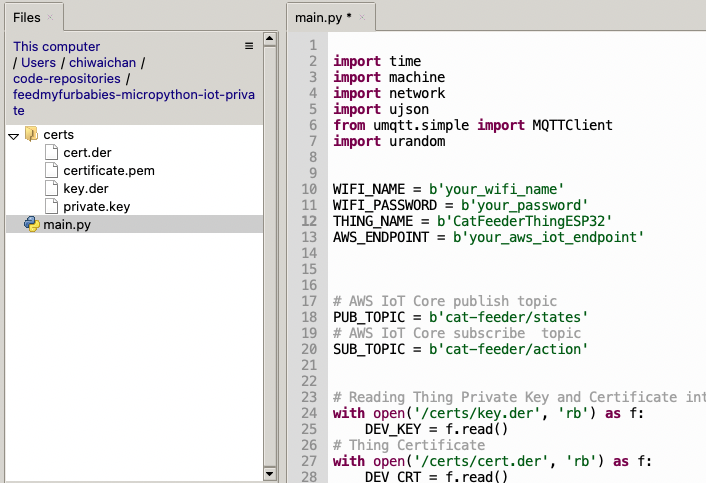
Select both the certs folder and main.py in the Files explorer, then right click and select "Upload to /" to upload the code to your micro-controller; the files will appear in the "MicroPython Device" file explorer.

This is the moment we've been waiting for, lets run the main.py Python script by clicking on the Play Icon in green.

If all goes well you should see some output in the Shell section of Thonny.
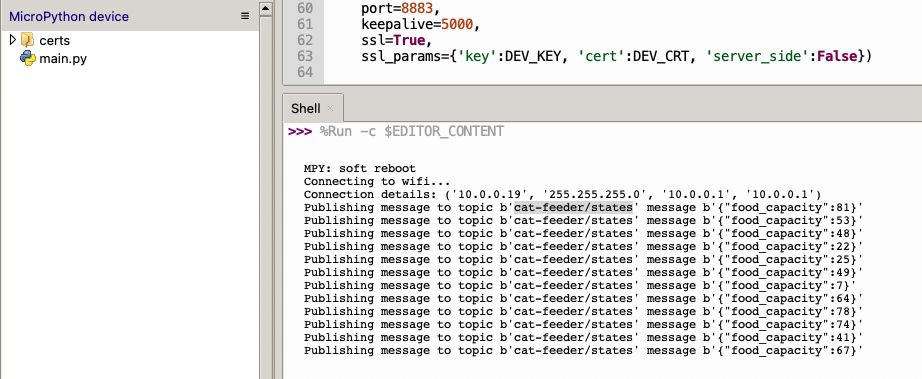
The code in the main.py file has a piece of code that is generating a random number for the food_capacity percentage property in the MQTT message; you can customise the message to fit your use case.
But lets verify it is actually received by AWS IoT Core.
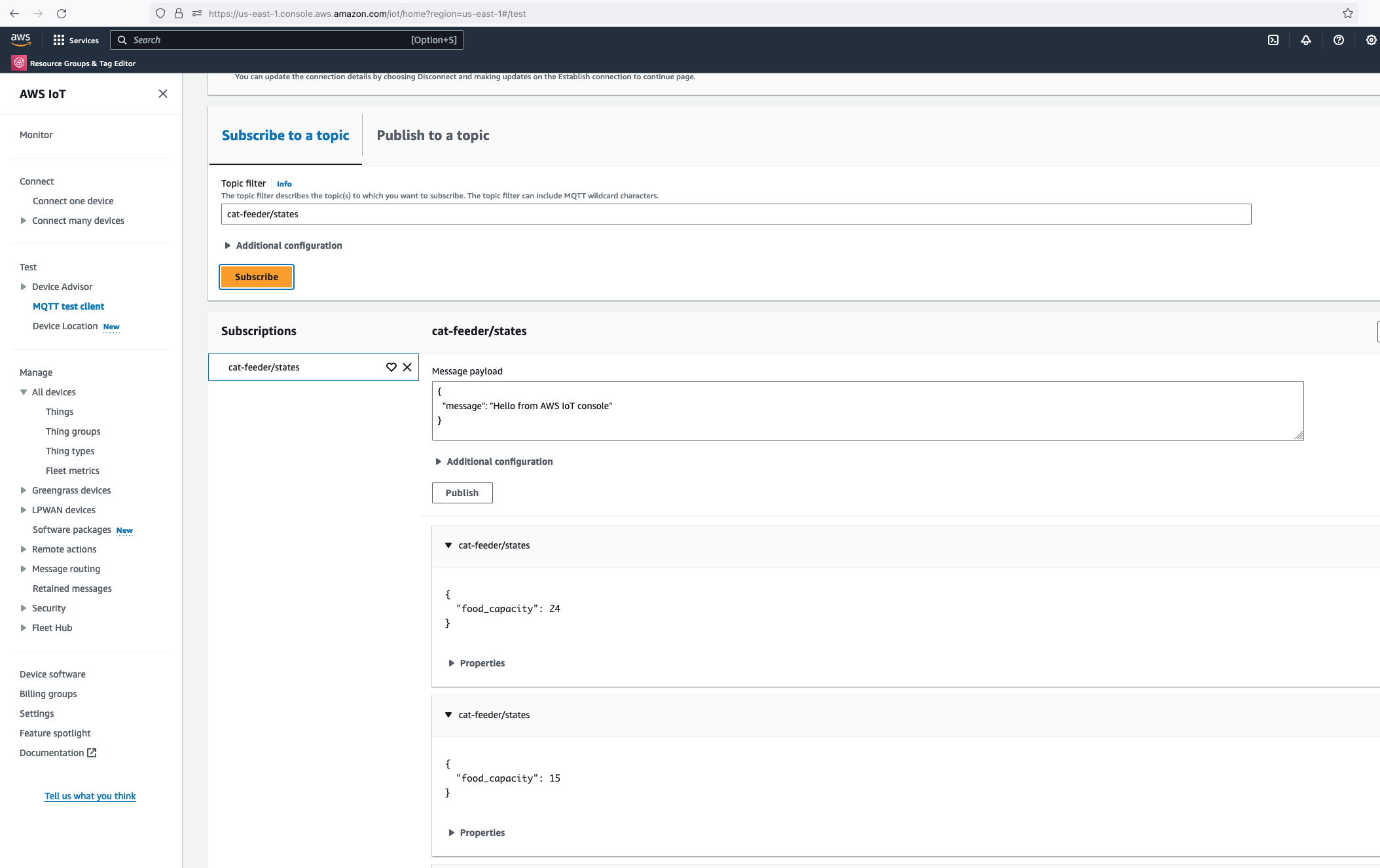
Alright, lets go the other way and see if we can receive MQTT messages from AWS IoT Core using the other Topic called "cat-feeder/action" we subscribed to in the MicroPython code.
Lets go back the AWS Console and use the MQTT test client to publish a message.
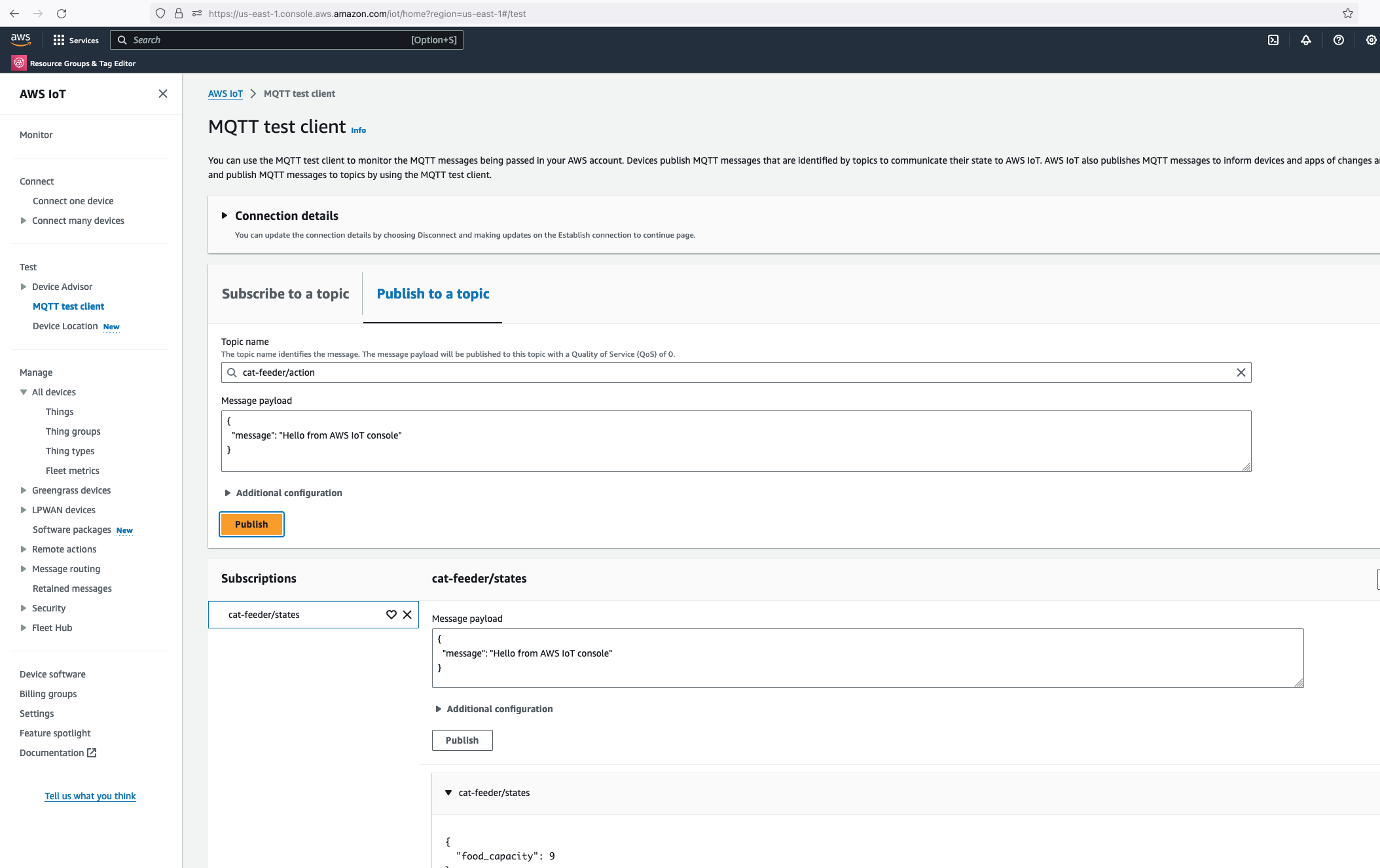

In the Thonny Shell we can see the message "Hello from AWS IoT console" sent from the AWS IoT Core side and it being received by the micro-controller.
FeedMyFurBabies – Using Custom Resources in AWS CDK to create AWS IoT Core Keys and Certificates
In a previous blog I talked about switching from CloudFormation template to AWS CDK as my preference for infrastructure as code, for provisioning my AWS Core IoT resources; I mentioned at the time whilst using resources using AWS CDK, as it would improve my productivity to focus on iterating and building. Although I switched to CDK for the reasons I described in my previous blog, there are some CloudFormation limitations that cannot be addressed just by switching to CDK alone.
In this blog I will talk about CloudFormation Custom Resources:
- What are CloudFormation Custom Resources?
- What is the problem I am trying to solve?
- How will I solve it?
- How am I using Custom Resources with AWS CDK?
CloudFormation Custom Resources allows you to write custom logic using AWS Lambda functions to provision resources, whether these resources live in AWS (you might ask why not just use CloudFormation or CDK: keep reading), on-premise or in other public clouds. These Custom Resource Lambda functions configured within a CloudFormation template, and are hooked into a CloudFormation Stack's lifecycle during the create, update and delete phases - to allow these lifecycle stages to happen, the logic must be implemented into the Lambda function's code.
What is the problem I am trying to solve?
In my AWS IoT Core reference architecture, it relies on use of two sets of certificates and private keys; they are used to authenticate each Thing devices connecting to AWS IoT Core - this ensures that only trusted devices can establish a connection.
In the CloudFormation template version of my reference architecture, I had in the deployement instructions to manually create 2 Cetificates in the AWS Console for the IoT Core service, this is because CloudFormation doesn't directly support creation of certificates for AWS IoT Core; as shown in the screenshot below.
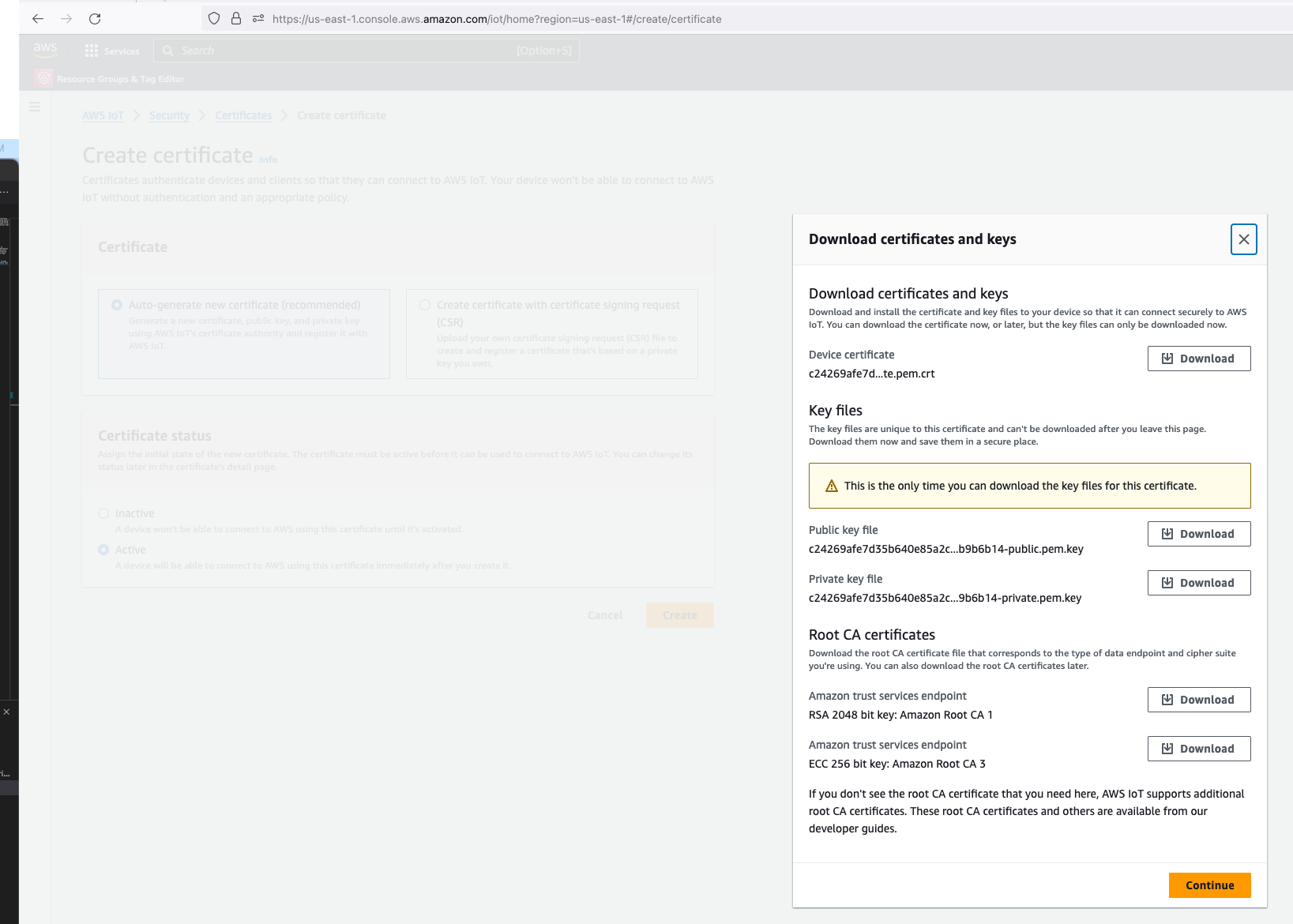
There is nothing wrong with creating the certificates manually within the AWS Console when you are trying out my example for the purpose of learning, but it would best to be able to deploy an entire set of resources using infrastructure as code, so we can achieve consistent repeatable deployments with as minimal effort as possible. If you are someone completely new to AWS, coding and IoT, my deployment instructions would be very overwheling and the chances of you successfully deploying a fully functional example will be very unlikely.
How will I solve it?
If you got this far and actually read what was written up to this point, you probably would have guess the solution is Custom Resources: so lets talk about how the problem described above was solved.
So we know Custom Resources is part of the solution, but one important thing we need to understand is that, even though there isn't the ability to create the certificates directly using CloudFormation, but there is support for creating the certificates using the AWS SDK Boto3 Python library: create_keys_and_certificate.
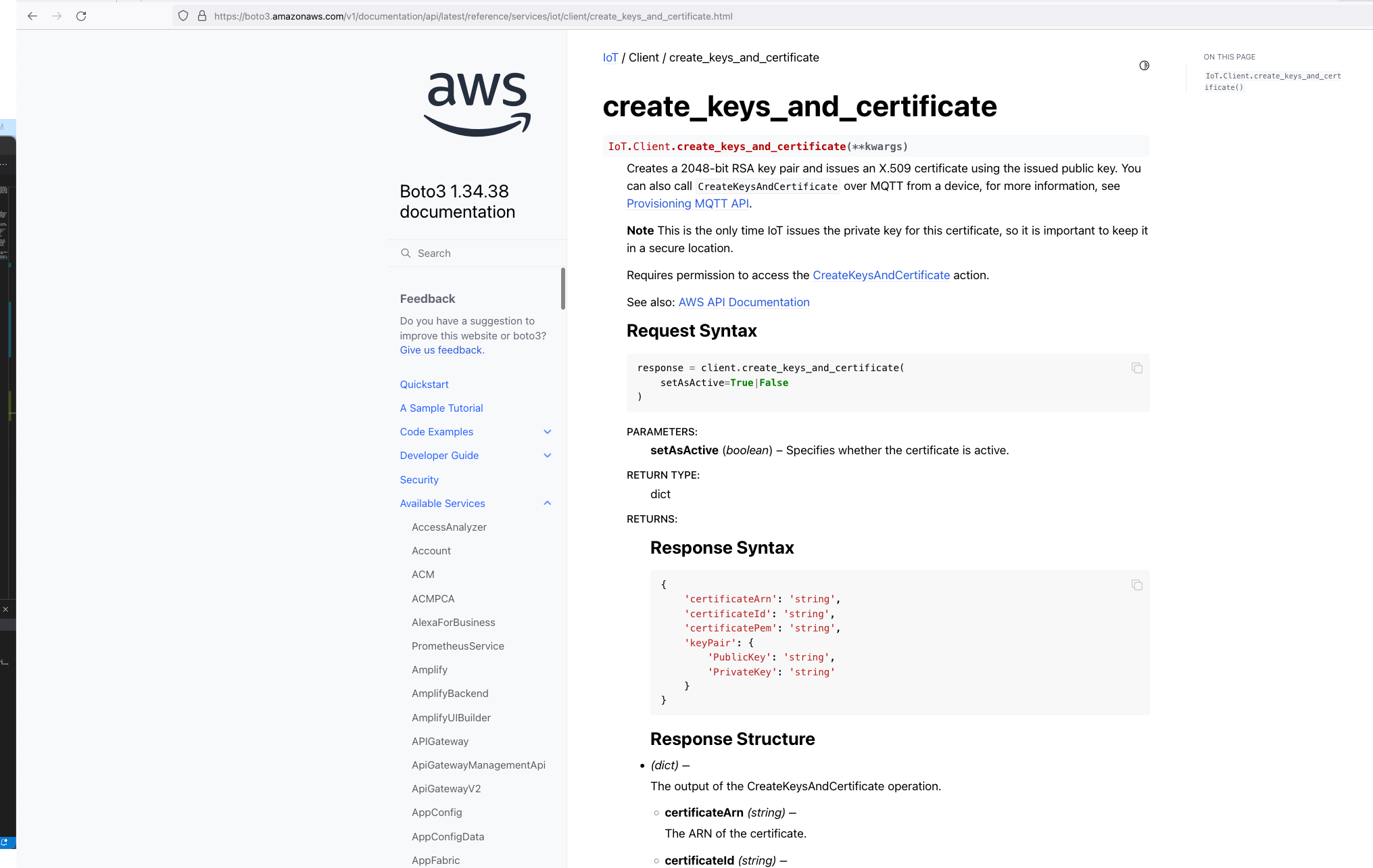
So essentially, we are able create the AWS IoT Core certificates using CloudFormation (in an indirectly way) but it requires the help of Custom Reources (a Lambda function) and the AWS Boto3 Python SDK.
The Python code below is what I have in the Custom Resource Lambada function, it demonstrates the use of the Boto3 SDK to create the AWS IoT Core Certificates; and as a bonus, I am leveraging the Lambda function to save the Certificates into the AWS Systems Manager Parameter Store, this makes it much more simplier by centralising the Certificates in a single location without the engineer deploying this reference architecture having to manually copying/pasting/managing the Certificates - as I have forced readers in my original version of this reference architecture deployment. The code below also manages the lifecycle of the Certificates as the CloudFormation Stacks are deleted, by deleting the Certificates it created during the create phase of the lifecycle.
The overall flow to create the certificates is: Create a CloudFormation Stack --> Invoke the Custom Resource --> invoke the Boto3 IoT "create_keys_and_certificate" API --> save the certificates in Systems Manager Parameter Store
import os
import sys
import json
import logging as logger
import requests
import boto3
from botocore.config import Config
from botocore.exceptions import ClientError
import time
logger.getLogger().setLevel(logger.INFO)
def get_aws_client(name):
return boto3.client(
name,
config=Config(retries={"max_attempts": 10, "mode": "standard"}),
)
def create_resources(thing_name: str, stack_name: str, encryption_algo: str):
c_iot = get_aws_client("iot")
c_ssm = get_aws_client("ssm")
result = {}
# Download the Amazon Root CA file and save it to Systems Manager Parameter Store
url = "https://www.amazontrust.com/repository/AmazonRootCA1.pem"
response = requests.get(url)
if response.status_code == 200:
amazon_root_ca = response.text
else:
f"Failed to download Amazon Root CA file. Status code: {response.status_code}"
try:
# Create the keys and certificate for a thing and save them each as Systems Manager Parameter Store value later
response = c_iot.create_keys_and_certificate(setAsActive=True)
certificate_pem = response["certificatePem"]
private_key = response["keyPair"]["PrivateKey"]
result["CertificateArn"] = response["certificateArn"]
except ClientError as e:
logger.error(f"Error creating certificate, {e}")
sys.exit(1)
# store certificate and private key in SSM param store
try:
parameter_private_key = f"/{stack_name}/{thing_name}/private_key"
parameter_certificate_pem = f"/{stack_name}/{thing_name}/certificate_pem"
parameter_amazon_root_ca = f"/{stack_name}/{thing_name}/amazon_root_ca"
# Saving the private key in Systems Manager Parameter Store
response = c_ssm.put_parameter(
Name=parameter_private_key,
Description=f"Certificate private key for IoT thing {thing_name}",
Value=private_key,
Type="SecureString",
Tier="Advanced",
Overwrite=True
)
result["PrivateKeySecretParameter"] = parameter_private_key
# Saving the certificate pem in Systems Manager Parameter Store
response = c_ssm.put_parameter(
Name=parameter_certificate_pem,
Description=f"Certificate PEM for IoT thing {thing_name}",
Value=certificate_pem,
Type="String",
Tier="Advanced",
Overwrite=True
)
result["CertificatePemParameter"] = parameter_certificate_pem
# Saving the Amazon Root CA in Systems Manager Parameter Store,
# Although this file is publically available to download, it is intended to provide a complete set of files to try out this working example with as much ease as possible
response = c_ssm.put_parameter(
Name=parameter_amazon_root_ca,
Description=f"Amazon Root CA for IoT thing {thing_name}",
Value=amazon_root_ca,
Type="String",
Tier="Advanced",
Overwrite=True
)
result["AmazonRootCAParameter"] = parameter_amazon_root_ca
except ClientError as e:
logger.error(f"Error creating secure string parameters, {e}")
sys.exit(1)
try:
response = c_iot.describe_endpoint(endpointType="iot:Data-ATS")
result["DataAtsEndpointAddress"] = response["endpointAddress"]
except ClientError as e:
logger.error(f"Could not obtain iot:Data-ATS endpoint, {e}")
result["DataAtsEndpointAddress"] = "stack_error: see log files"
return result
# Delete the resources created for a thing when the CloudFormation Stack is deleted
def delete_resources(thing_name: str, certificate_arn: str, stack_name: str):
c_iot = get_aws_client("iot")
c_ssm = get_aws_client("ssm")
try:
# Delete all the Systems Manager Parameter Store values created to store a thing's certificate files
parameter_private_key = f"/{stack_name}/{thing_name}/private_key"
parameter_certificate_pem = f"/{stack_name}/{thing_name}/certificate_pem"
parameter_amazon_root_ca = f"/{stack_name}/{thing_name}/amazon_root_ca"
c_ssm.delete_parameters(Names=[parameter_private_key, parameter_certificate_pem, parameter_amazon_root_ca])
except ClientError as e:
logger.error(f"Unable to delete parameter store values, {e}")
try:
# Clean up the certificate by firstly revoking it then followed by deleting it
c_iot.update_certificate(certificateId=certificate_arn.split("/")[-1], newStatus="REVOKED")
c_iot.delete_certificate(certificateId=certificate_arn.split("/")[-1])
except ClientError as e:
logger.error(f"Unable to delete certificate {certificate_arn}, {e}")
def handler(event, context):
props = event["ResourceProperties"]
physical_resource_id = ""
try:
# Check if this is a Create and we're failing Creates
if event["RequestType"] == "Create" and event["ResourceProperties"].get(
"FailCreate", False
):
raise RuntimeError("Create failure requested, logging")
elif event["RequestType"] == "Create":
logger.info("Request CREATE")
resp_lambda = create_resources(
thing_name=props["CatFeederThingLambdaCertName"],
stack_name=props["StackName"],
encryption_algo=props["EncryptionAlgorithm"]
)
resp_controller = create_resources(
thing_name=props["CatFeederThingControllerCertName"],
stack_name=props["StackName"],
encryption_algo=props["EncryptionAlgorithm"]
)
# The values in the response_data could be used in the CDK code, for example used as Outputs for the CloudFormation Stack deployed
response_data = {
"CertificateArnLambda": resp_lambda["CertificateArn"],
"PrivateKeySecretParameterLambda": resp_lambda["PrivateKeySecretParameter"],
"CertificatePemParameterLambda": resp_lambda["CertificatePemParameter"],
"AmazonRootCAParameterLambda": resp_lambda["AmazonRootCAParameter"],
"CertificateArnController": resp_controller["CertificateArn"],
"PrivateKeySecretParameterController": resp_controller["PrivateKeySecretParameter"],
"CertificatePemParameterController": resp_controller["CertificatePemParameter"],
"AmazonRootCAParameterController": resp_controller["AmazonRootCAParameter"],
"DataAtsEndpointAddress": resp_lambda[
"DataAtsEndpointAddress"
],
}
# Using the ARNs of the pairs of certificates created as the PhysicalResourceId used by Custom Resource
physical_resource_id = response_data["CertificateArnLambda"] + "," + response_data["CertificateArnController"]
elif event["RequestType"] == "Update":
logger.info("Request UPDATE")
response_data = {}
physical_resource_id = event["PhysicalResourceId"]
elif event["RequestType"] == "Delete":
logger.info("Request DELETE")
certificate_arns = event["PhysicalResourceId"]
certificate_arns_array = certificate_arns.split(",")
resp_lambda = delete_resources(
thing_name=props["CatFeederThingLambdaCertName"],
certificate_arn=certificate_arns_array[0],
stack_name=props["StackName"],
)
resp_controller = delete_resources(
thing_name=props["CatFeederThingControllerCertName"],
certificate_arn=certificate_arns_array[1],
stack_name=props["StackName"],
)
response_data = {}
physical_resource_id = certificate_arns
else:
logger.info("Should not get here in normal cases - could be REPLACE")
send_cfn_response(event, context, "SUCCESS", response_data, physical_resource_id)
except Exception as e:
logger.exception(e)
sys.exit(1)
def send_cfn_response(event, context, response_status, response_data, physical_resource_id):
response_body = json.dumps({
"Status": response_status,
"Reason": "See the details in CloudWatch Log Stream: " + context.log_stream_name,
"PhysicalResourceId": physical_resource_id,
"StackId": event['StackId'],
"RequestId": event['RequestId'],
"LogicalResourceId": event['LogicalResourceId'],
"Data": response_data
})
headers = {
'content-type': '',
'content-length': str(len(response_body))
}
requests.put(event['ResponseURL'], data=response_body, headers=headers)
How I am using Custom Resources with AWS CDK?
What I am about to describe in this section can also be applied to a regular CloudFormation template, as a matter of fact, CDK will generate a CloudFormation template behind the scenes during the Synth phase of the CDK code in the latest version of my IoT Core reference architecture implemented using AWS CDK: https://chiwaichan.co.nz/blog/2024/02/02/feedmyfurbabies-i-am-switching-to-aws-cdk/
If you want to get straight into deploying the CDK version of reference architecture, go here: https://github.com/chiwaichan/feedmyfurbabies-cdk-iot
In my CDK code, I provision the Custom Resource lambda function and the associated IAM Roles and Polices using the Python code below. The line of code "code=lambda_.Code.from_asset("lambdas/custom-resources/iot")" loads the Custom Resource Lambda function code shown earlier.
# IAM Role for Lambda Function
custom_resource_lambda_role = iam.Role(
self, "CustomResourceExecutionRole",
assumed_by=iam.ServicePrincipal("lambda.amazonaws.com")
)
# IAM Policies
iot_policy = iam.PolicyStatement(
actions=[
"iot:CreateCertificateFromCsr",
"iot:CreateKeysAndCertificate",
"iot:DescribeEndpoint",
"iot:AttachPolicy",
"iot:DetachPolicy",
"iot:UpdateCertificate",
"iot:DeleteCertificate"
],
resources=["*"] # Modify this to restrict to specific secrets
)
# IAM Policies
ssm_policy = iam.PolicyStatement(
actions=[
"ssm:PutParameter",
"ssm:DeleteParameters"
],
resources=[f"arn:aws:ssm:{self.region}:{self.account}:parameter/*"] # Modify this to restrict to specific secrets
)
logging_policy = iam.PolicyStatement(
actions=[
"logs:CreateLogGroup",
"logs:CreateLogStream",
"logs:PutLogEvents"
],
resources=["arn:aws:logs:*:*:*"]
)
custom_resource_lambda_role.add_to_policy(iot_policy)
custom_resource_lambda_role.add_to_policy(ssm_policy)
custom_resource_lambda_role.add_to_policy(logging_policy)
# Define the Lambda function
custom_lambda = lambda_.Function(
self, 'CustomResourceLambdaIoT',
runtime=lambda_.Runtime.PYTHON_3_8,
handler="app.handler",
code=lambda_.Code.from_asset("lambdas/custom-resources/iot"),
timeout=Duration.seconds(60),
role=custom_resource_lambda_role
)
# Properties to pass to the custom resource
custom_resource_props = {
"EncryptionAlgorithm": "ECC",
"CatFeederThingLambdaCertName": f"{cat_feeder_thing_lambda_name.value_as_string}",
"CatFeederThingControllerCertName": f"{cat_feeder_thing_controller_name.value_as_string}",
"StackName": f"{construct_id}",
}
# Create the Custom Resource
custom_resource = CustomResource(
self, 'CustomResourceIoT',
service_token=custom_lambda.function_arn,
properties=custom_resource_props
)
When you execute a "cdk deploy" using the CLI on the CDK reference architecture, CDK will synthesize from the Python CDK code, a CloudFormation template, and then create a CloudFormation Stack using the synthesized CloudFormation template for you.
For more details on the CDK AWS IoT reference architecture and deployment instructions, please visit my blog: https://chiwaichan.co.nz/blog/2024/02/02/feedmyfurbabies-i-am-switching-to-aws-cdk/
